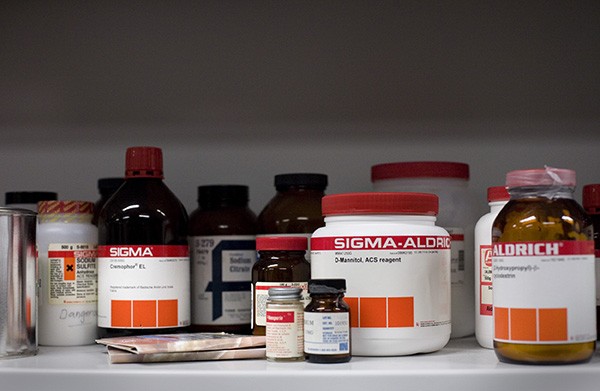Environmental, Health & Safety:
514-848-2424, ext. 4877
Chemical Waste Disposal Procedures

What is chemical waste?
Chemical waste is mainly generated from chemical by-products of laboratory work, as well as expired chemicals. They include solids, liquids or gases containing or contaminated with any of the following:
- flammable solvents (e.g., acetone, alcohols, acetonitrile)
- leachate toxic materials (e.g., heavy metals,)
- corrosives (e.g., hydrochloric acid, potassium hydroxide pellets)
- reactives such as oxidizers, cyanides, sulphides, explosives, unstable materials and water-reactive materials (e.g., sodium metal, benzoyl peroxide)
- toxic materials including mutagenic, carcinogenic, acute or chronic toxicity materials (e.g., chloroform, ethidium bromide)
- non-returnable gas cylinders
For more details, please refer to the different chemical waste disposal guidelines.
- Waste Disposal Request Form
- Chemical Waste Disposal Guidelines English/French
- Clean Broken Glass Disposal Procedures
- Solvent Bottle Disposal Procedure
- QRG-Hazardous Waste Labels
- Simplified Chemical Compatibility Storage Guideline WHMIS 2015/WHMIS1988
- Detailed Chemical Compatibility Chart
When the hazardous chemical(s) is ready to be picked-up, the following procedure must be followed:
- Complete the “Hazardous Waste Disposal Request Form” by including the date, room number, phone extension and signature. Chemical Waste Disposal Form
- Include all the details about the hazardous waste (chemical name, quantity, container size). In the case of mixtures, please write down approximated percentage of each component.
- Properly fill in the label on the waste container. Avoid using abbreviations.
- For mixed waste, indicate approximate percentage of contents in order of highest to lowest concentration.
- Send the completed form to EHS by e-mailing a scanned copy to hazardouswaste@concordia.ca
- Hazardous waste pickups are generally done on Tuesday and on Friday at the Loyola Campus and on Thursday at the SGW Campus.
- Request for special hazardous waste pick-up (emergency, bulk quantities, drums) are to be sent to EHS via e-mail to hazardouswaste@concordia.ca.
- Respect the compatibility of hazardous waste content prior to mixing. For more information refer to the Laboratory Safety Manual
- Allow 10 to 20% of free space in liquid hazardous waste containers to allow for solvent expansion. Overfilled and/or leaking containers will not be accepted.
- All full containers should be placed in a designated area in each laboratory/workshop, preferably not too far from the exit door, with the waste disposal label visible. Do not obstruct exit doors with the containers.
- A tray or secondary container should be placed underneath the waste containers to avoid any spill/leaks.
- Mercury chemical waste (e.g. old thermometers) should be clearly identified.
These include powders, silica, sand, celite (or any other filtering media), contaminated paper, glassware, gloves or any other solid materials that have been contaminated with chemicals. The following plastic containers should be used for their disposal:
• 4-litre wide-mouth container
• 20-litre white pails
If chemical waste is generated in large quantities that cannot be easily disposed of in our regular waste containers, special barrels for bulk chemical waste are required. Please contact EHS at hazardouswaste@concordia.ca to request a barrel.
Bulk Liquid Chemical Waste Container:
Volume: 45-gallon (210-liter) barrel
Material: plastic
Use: oil, organic, corrosive, aqueous
Bulk Solid Chemical Waste Container:
Volume: 45-gallon (210-liter) barrel with plastic lining inside
Material: metal
Use: non-corrosive chemicals and other contaminated materials
Empty solvent bottles can be disposed of via regular garbage as long as they are properly cleaned. To properly clean a chemical bottle:
- Triple rinse the bottle
- Remove original chemical labels and/or write “rinsed” on the label
- Remove the cap
- For more details refer to the Solvent Bottle Disposal Procedure
Bottles and other glass containers used to contain or hold chemicals cannot be recycled. 4-Litre solvent glass bottles and other re-sealable chemical containers can be used for waste collection and storage, as long as they are in good condition. The labels are to be removed and the containers are clearly identified with a Concordia waste label.
Unknown hazardous material cannot be accepted for disposal.
If you have unknown hazardous materials contact EHS at hazardouswaste@concordia.ca.







